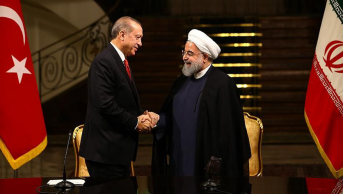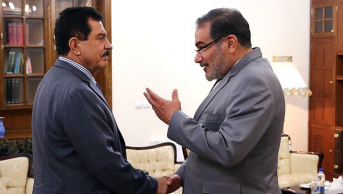From 2011 to Astana: The Cost of Iranian Policy Towards Syria

Iran has stood behind the Assad administration since the outset of demonstrations against the regime in Syria. The initial differences among some Iranian officials regarding the meaning of the demonstrations in Syria, and responses of the Assad administrationsoon replaced by a policy that envisaged standingbehindAssad. Ayatollah Khamenei, the Supreme Leader of the Islamic Revolution,proclaimed in June 2011 thatIran would stand behind the Syrian regime in the face of the opposition protests, which, heclaimed, were organized by external forces, and served American and Israeli interests.
Although the content and rhetoric of Iranian support for the Assad administrationhave changed over time, the essence of this policy has not changed. The scope of the military and economic support to the regime provided byIran that has never withdrawn her political support from Assad,has gradually expanded.
Support for the Assad Regime
The Iranian support was initially limited to providingadvisory services and technical assistance to the Syrian security forces in suppressing anti-regime demonstrations. After the deepening of conflict between the armed opposition and the regime, Iran has directly or indirectly involved in clashes. The increasing numbers of Quds Forceofficers affiliated to the Islamic Revolutionary Guards Corpshave come to Syria in order to provide 'military consultancy' service to the Syrian forces.
The Lebanese Hezbollah,promoted by Iran, has sided with the regime forces and actively taken part in the clashes since the beginning of 2013. Additionally, the Shiite militia forces from Iraq, Afghanistan and Pakistan were mobilizedin the name of protectingthe Sayyidah Zaynab Shrine,and they backed up the regime forces. Since the regime forces were unable to take control of country,the Iranian government has increased its military forces in Syria from September 2015 onward; volunteer militia forces and special forces such as the 65th Airborne Brigade were sent to Syria.
It is not known exactly how many Iranian soldiers are in Syria. It was estimated that there were about 2,000 Iranian warriors in Syria by the middle of 2015. However, as mentioned above, the number of Iranian warriors has increased in the last year. According to a report published in September 2016by the National Resistance Council (People's Mujahedeen Organization of Iran -PMOI) thatopposes the Islamic Republic regime in Iran, 8-10 thousand troops from the Revolutionary Guards and 5-6 thousand troops from the army have been deployed in Syria. The same rapport claimed that besides7-10 thousand Hezbollah militants, 20 thousand Iraqi and 15-20 thousandAfghan militants, and 5-7 thousand militants from Pakistan, Palestine and some other countrieswere fighting in Syria under the control of Iran. These figures provided by the PMOI may have been exaggerated; nevertheless, the fact that Iran is not transparent in this regard opens the way for speculation.
Military losses and Economic cost
Iran lost more than 30 generals,including Hassan Shateri who ruled his country’s military operations in Syria, and his successor Hossein Hamadani, and many soldiers in the conflict. Mohammad Ali Shahidi Mahallati, Director of Foundation of Martyrs and Veterans Affairs, declared in his statement on November 22, 2016 that "the number of Iranians martyred in Syria for defending the Shrine exceeded a thousand." According to thePMOIclaims, the IRGC alone has lostaround 1,500 fighters. Losses of foreign Shia fighters who are operating under the Iranian command are in total more than 10 thousand. However, there is no clear information regarding military losses.
The continuous support for the Assad regimehas some economic burdens for Iran, as well. Iran became the main supplier of basic consumption goods, oil, weapons and ammunition, which Syria needed in the course of the civil war. Iran also directly provided the Assad regime with financial assistance. In addition, the expenses of training and equipment, and salaries of the militia forces that are sent to Syria for fightingwith the Assad regimeare again covered by Iran. Shia militias that fightunder the command of Iranare reportedly paid between 500 and 1000 US dollars per month.
Total economic costfor continuous Iranian involvementin the war in Syria is unknown. Staffan de Mistura, the Special Envoy of the UN and the Arab League to Syria put forward that Iran spends approximately6 billion dollars per year in support of the Syrian regime. However, some researchers claim that the cost of supporting Assad for Iran amounts on average to 15-20 billion dollars a year. Thus, it is estimated that up to now Iran has spentabout 100 billion dollars.
Regional implications of Iran’s Syria policy
The Iranian resolve to support the Assad's administration has also affected its foreign relations. Shortly after the beginning of the crisis, the US and the European Union began imposing sanctions on some Iranian figures and institutions because of the military support they gave to the Assad regime. Iran, on the other hand, severely blamed regional countries such as Turkey and Saudi Arabia,who have actively supported the Syrian opposition. Along with some other regional disputes, the tension between Iran and these two countries, Turkey and Saudi Arabia, who have been confronted each other in the Syrian crisis, has escalated at some times. While Iran accused these countries of interfering in Syria's internal affairs and supporting terrorists, Turkey and Saudi Arabia blamed Iran for supporting a cruel dictator due to its own regional and sectarian ambitions.
Iranthat supports the Assad regime without any conditionwas excluded from international conferences that sought peaceful solution of the crisis in Syria. A 'quadruple dialogue group' wasset up between Turkey, Iran, Egypt and Saudi Arabia in September 2012; nonetheless,after the withdrawal of Saudi Arabia, this initiative lost its essence. In the wake of the nuclear deal in 2015, Iran has been considered by the Western states as a regional partner for the solution of regional affairs. For the first time, Iran was invited by the US and Russian foreign ministers to an international meeting in Vienna on October 31, 2015, and thus Iran became a member of the International Syrian Support Group (ISSG).
The 'counter-revolutionary' role that Iran played in the Syrian crisis has extremely tarnished its image in the Arab and Islamic world. According to the Global Attitudes & Trends survey conducted by the Pew Research Center in 2015, the percentage of those who expressed positive views on Iran fell dramatically in many Islamic countries compared to the data obtained in 2006-2007. In the Arab and Islamic world, on average 58 percent of the population express a negative opinion about Iran.
One of the regional reflections of Iran's Syria policy is the regionalization of sectarian divisions. Iran mobilizesparticularly Shia warriors to defend the Shiite sanctuaries and to 'fight against the takfiriterrorists'. This situation has sharpened the sectarian consolidation both around Iran and against it. As a result, while the popularity of Iran has decreased across the wider Arab and Islamic world, the number of Iraqi, Lebanese, and Pakistani Shi'ites who sympathize with Iran is increasing. Likewise, the countries, which are mostly sympathized with by the Iranians in the Middle East are Syria and Iraq.
Additionally, Iranian determination to stand behind Assad has worsened its image among the Syrian opposition. Many opposition groups,who have seen Iran as an invading force in Syria, claim that they have beenfightingnot only against the Assad regime, but also against the‘Safavid Iran'.
Internal political implications of Iran’sSyria policy
One of the decisiveoutcomesof Iranian involvement in the Syrian crisis is the rising influence of the Revolutionary Guards in foreign policy. In addition to military and security aspects of the Syrian crisis for Iran, ideological and geopolitical dimensions of this conflict have led IRGCplay a more active role in Iranianpolicy towards Syria. Today, it is deemed thatQasem Soleimani, commander the Quds Force, has controlled the filesof Iraq and Syria.
Another prominent figure,who play an active role in Iranian policy towards Syria, is Ali Akbar Velayati, former Foreign Minister and adviser of Ayatollah Khamenei on foreign policy issues. Recently, Admiral Ali Shamhani, one of the former commanders of the Revolutionary Guards, the current Secretary of the Supreme National Security Councilhas come forward with his mission as the coordinator of relations between Iran, Russia and Syria. Therefore, the office of President,and the Ministry of Foreign Affairs that were expected to carry out Iranian foreign policy have begun to play subsidiary roles instead of formulating and implementing policies.
Despite all the previouslymentioned costs and challenges above, there is a very weak opposition in Iran to criticize policy towards Syria. It is understandable that there is a certain amount of consensus among variousfactions on this ground. However, the fact that the leaders of the "Green Movement" have been put under house arrest and that the opposition has been severely suppressed also makes it hardto criticize Iranian government.
The militarization and securitization of Iran's Syria policy have increased the level of authoritarianism and prevented the formulation of alternative politics. Perhaps this is the greatest price for the war in Syria for Iran. Only Hashemi Rafsanjani, who passed away in the last week, dared to speak againsthis country’s handling of the Syrian crisis on several occasions. In a speech he delivered in August 2013, Rafsanjani said that the Assad regimeused chemical weapons and tyrannized his people. In an interview in May 2016, drawing attention to his country's engagements in the region, particularly in Syria and Iraq he pointed out thatit would not be sustainable and that Iran would day by day getinto a scrape in the region.
Rafsanjani's criticisms did not arouse much interest in the public opinion. Moreover, a survey conducted in early 2016 revealed that most of the Iranian people were in favour of their government’s sending troops to Syria, and maintaining its support for Assad. Indeed, the emergence of the ISIS as a serious threat has made Iranians moresupportive forIran’s Syria policy. As a matter of fact, it is seen that many Iranians are more interested in fighting against ISIS than safeguarding Assad's power.
Astana
What did Iran gain in Syria in return for all the prices she paid? The Assad regimeis still standing, but itcannot control a significant part ofthe country. All Syria is in ruins. Moreover, the Iranian support was insufficient to keep Assad on his feet, and Iran lost a significant part of her role to Russia. Nevertheless, she has been a part of the efforts for international solutions from whichshe was excluded for a long time. The tripartite meeting in Moscow on December 21, 2016 enabled Iran to stand outin this process.
Under these circumstances, Iran,as a party to the Moscow Declaration, is now trying to be one of the architects of the Syrian peace process in Astana. Iran will work there for a building a consensus on a transition process under the stewardship of Assad. Thus, she aims both to recoverher regional popularity to some extent, and to have a say in the future of Syria. The prospective positive outcomes that would be yielded in Astana will also help to satisfy Iran's search for regional status.
This article was published on the web page of Al Jazeera Turk with the title " 2011’den Astana’ya: Suriye Politikasının İran’a Maliyeti".











